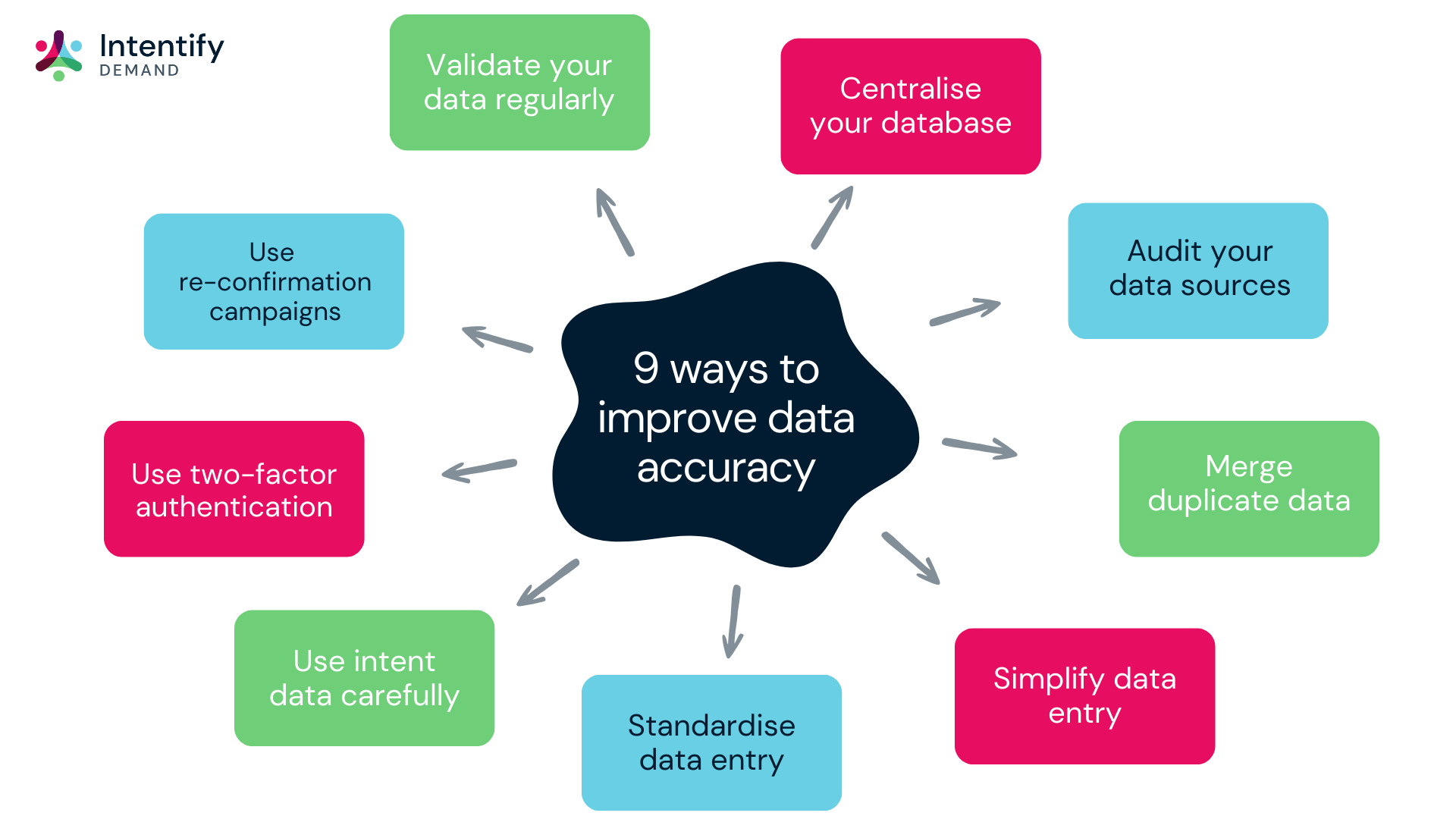Read time: 8 minutes
In a world where customer engagement is so vital, personalisation is undeniably so crucial. However, without precise, top-tier data, even the most well-intentioned personalisation efforts can miss the mark. It's therefore equally important that data accuracy is on par with personalisation to ensure your efforts are maximised.
- Will Smibert, CEO
Personalisation is the key to connecting with your customers and showing them that you recognise and value them as individuals.
But being able to engage with them in this way requires accurate, high-quality data.
Without it, your attempts at personalisation will ultimately fall short of the intended mark. This can look unprofessional and will cost you customers.
The trouble is, around 25-30% of your data becomes inaccurate every year. That’s over a quarter of your existing data now irrelevant or outdated.
As an already busy marketing professional, how are you supposed to keep up?
Well, the good news is through strategic planning (and a few other key steps) you can fix your data accuracy and overcome these challenges to ensure that your data is performing as it should be.
Personalisation is the key to connecting with customers
It’s undeniable that personalisation in marketing is becoming increasingly important.
Over half of B2C buyers (52.5%) say a brand's personalisation efforts will have an impact on whether they choose one brand over another, according to MoEngage's 2023 Personalisation Pulse Check. In fact, research from Adobe and Forrester found that 66% of B2B buyers expect the same or better personalisation in their professional lives (vs. their personal lives), with 87% expecting to be delighted both before and after their purchase.
And the thing is, it works. Research from Twilio Segment found that:
- 56% of consumers will become repeat buyers after a personalised experience
- 80% of business leaders say consumers spend more when their experience is personalised
- 62% of business leaders claim customer retention has improved 62% as a result of personalisation efforts
All of this points to personalisation being an effective tool for marketers looking to improve ROI and retain customers. And that's because effective personalisation allows you to:
- Better meet customer expectations and demands
- Improve customer relationships and enhance the user experience
- Create and share content that is relevant to them as individuals
- Build a loyal customer base that feels appreciated and understood
- Encourage customers to interact with a brand through different touchpoints
- Gain a competitive edge over those who aren’t doing this as well
So how can inaccurate data impact your personalisation efforts?
Effective personalisation is not possible with inaccurate data. In fact, inaccurate data can cost your business valued customers and anywhere between 15 to 25% of your annual revenue.
If potential buyers are receiving irrelevant or incorrect messages and ineffective personalised recommendations, they're more likely to opt out of your marketing communications or stop buying from your brand altogether.
- Will Smibert, CEO
For example, if a prospect's situation has changed over the last 12 months but your data doesn't reflect this, you might target them with older, outdated products they no longer need. Or worse, say a prospect has become a customer and has already bought from you but your inaccurate data means you continue to target them with welcome offers. This is only going to cause them to disengage with you and make it unlikely they'll buy again in the future.
As individual circumstances change - if a prospect receives a promotion or changes company and now has a different set of responsibilities - your marketing and personalisation attempts must change to reflect this. But this is only possible with the most accurate data.
And as if all of that wasn’t enough, low-quality data can also negatively impact your data analytics and reporting, having a knock-on effect on your wider personalisation and marketing efforts in the future.
How to fix the problem and ensure data accuracy
Data management has never been a small job, but it is an important one. Thankfully, as new tools and technologies emerge, gathering, processing and managing data has become easier and far more accurate.
However, for many organisations, there is still a long way to go and if you want to ensure the success of your marketing campaigns, you need accurate marketing data.

Here are 9 ways you can improve data accuracy for better personalisation in your marketing campaigns.
1. Audit your data sources
If you've discovered quality issues with your data, the first and most important step is to audit your data sources. This allows your team to identify where most of your data is coming from, and how it's being collected, stored and processed.
An initial audit will help you to look for gaps, errors, duplicate entries, etc. and start to find any key issues with your existing sources and strategies.
2. Centralise your database
If you haven't already, you need to centralise your database to ensure that there is only one place that contains key customer information and that this can be accessed and updated regularly. This will act as your single source of truth for all things data.
- Will Smibert, CEO
And by having all your data in one single location, it is far easier to ensure that it is accurate, consistent and usable.
3. Validate your data regularly
Data can quickly go out of date. It's not a static line item so it's important to regularly clean and validate your data. This will highlight any errors, inconsistencies or anomalies and remove useless data from your systems.
But it will also help to identify any duplicate data entries to ensure that you’re not targeting customers too frequently, which can come across as spammy and potentially ruin the customer experience.
4. Use reconfirmation campaigns to stay up-to-date
If you've gathered email addresses, either through sales or sign-up forms, you'll have already used a validation process to prevent bots and ensure data accuracy. However, you need to use additional follow-ups to reconfirm contact information and keep your data up-to-date.
With reconfirmation campaigns, you can proactively encourage contacts to confirm their details and the type of information they're still interested in receiving.
5. Use two-factor authentication where appropriate
Introducing two-factor authentication, either when signing up, logging in or engaging with your digital content can ensure the accuracy and safety of your data.
Often, people will use their phone number to validate their email address. Not only is this great for password recovery and cybersecurity, but it shows consumers you care about how their data is used and protected.
It also offers personalisation opportunities in the form of another channel where you can interact with them and send personalised messages.
6. Use your intent data carefully
Intent data can also be an extremely useful tool for personalising your marketing campaigns and communications. It pulls together data at different touchpoints and monitors customer behaviour to provide insight into buying behaviour and predict when someone is likey to make a purchase.
If your information is not analysed or interpreted correctly, your insights and data won't be accurate. And this will impact how you target prospective customers and the personalised messages you put in front of them.
- Will Smibert, CEO
Get this wrong and it will cost you plenty of profitable opportunities.
7. Standardise the data entry process
Set up a standardised process for employees to enter or import data. Start with standard data entry formats and then develop this into a series of steps.
A company-wide data entry guide and standard operating procedures (SOPs) will ensure data is consistent and meets quality standards at the point of entry. This is a big time saver and can also save a lot of resources compared to needing to fix data that's already been fed into your marketing machine.
8. Simplify the data entry process
As well as standardising any data entry, re-evaluate your current entry processes and work out how to simplify them. This could be as easy as limiting the number of options within a particular field to reduce the likelihood of errors.
This is particularly important for manual data entry but should also be applied across any automation workflows and data-gathering projects.
9. Merge duplicate data
Duplicate data can happen for a number of reasons, such as human error or multiple external sources.
However, simply deleting a duplicate entry could lead to the accidental loss of information and leave your personalised campaigns addressed to First.Name. The easiest way to fix this is to merge duplicate files. Your database should be able to track version history and keep a record of changes that have happened to individual records.
How do we keep our data accurate?
As you already know, data accuracy is a constant battle for marketers looking to deliver truly personalised experiences. Duplicate records, poor data quality and quality management are ongoing issues.
Ensuring your data is accurate and remains so requires a strategic approach and forward-thinking. At Intentify Demand, data is our thing. Which means we often get asked: how do we keep our data accurate? And it's a valid question. With over 50 million links with publishers and company sites to gather intent, it's safe to say we have a lot of it.
- Will Smibert, CEO
Keeping all our data up to date is a huge undertaking. All our data goes through a 3-month quarantine to make sure it's both accurate and GDPR compliant. We also have a dedicated data team on hand who are responsible for everything outlined in this article.




